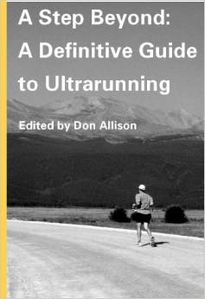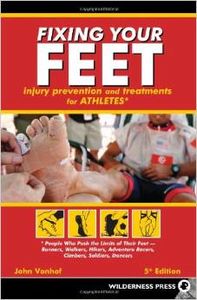Ultramarathon training plans for 100 miles, 100 Km, 50 miles and 50Km
Below are some selected ultramarathon training plans for various ultramarathon distances. I have not used any of these plans, but I have selected them on the basis of having a reasonable level of detail and some credibility. It's important to realize that there is little known about training for ultras, and while the books have the most detail, there's still a paucity of experience that backs them up. For those wanting a high level summary, here's my recommendations:
- Read both "Relentless Forward Progress" and the "Field Guide to Ultrarunning" as these books have good information and reading both gives you some balance.
- Consider Wolfgang's "Ultra Marathon Training", but only in addition to the two books mentioned above.
- Read the Umstead 100 guide; it's free, it's short, and it has some outstanding advice for any ultra.
- Consider the Runner's World 50 mile plan, but think of the other online plans as input to creating your own plan rather than as a complete plan.
- Read my advice around Ultrarunning.
- Consider reading books on marathon training. While the advice does not directly translate, it can provide insight into general training principles. See A Comparison of Marathon Training Plans for details.
| Plan | Distance | Max Long Run | Back To Back | Peak Weekly | Length (weeks) | Days/Week | Speedwork | Time/Distance | Level Of Detail | Notes |
|---|---|---|---|---|---|---|---|---|---|---|
| Run Your First Ultra | 100 Miles | 50 Mile or 100K Race | 45 + 12 miles | 100 miles | 48 | 5-6 | Yes | Distance | Detailed plan giving daily runs | See Below |
| Wolfgang's24 hour Plan | 24 Hours | 37 miles | 31 + 37 miles | 127 miles | 8 | 4-5 | Yes | Distance | Complete book | Prerequisite of sub 10hr 100K race, 2 week taper |
| Wolfgang'sWestern States 100 Mile Plan | 100 Miles | 37 miles | 15 + 43 miles | 93 miles | 8 | 5 | Yes | Distance | Complete book | Prerequisite of sub 10hr 100K race, 2 week taper |
| Relentless Forward Progress100 miles on 50 MPW | 100 Miles | 50 miles | 24+14 miles | 58 miles | 24 | 5 | Yes | Distance | Complete book | See Below |
| Relentless Forward Progress100 miles on 70 MPW | 100 Miles | 50 miles | 24+20 miles | 70 miles | 24 | 5 | Yes | Distance | Complete book | See Below |
| Ultra Ladies 100 Mile Plan | 100 Miles | 30 miles | 30+20 miles | 75 miles | 26 | 5 | No | Distance | Detailed plan giving daily runs | No details on paces for training runs, just distance |
| Umstead 100 Mile Plan | 100 Miles | 35-40 miles | No | 60-70 miles | 5 + 1 day speed walking | Suggested | N/A | Rough guide to each day of the week, but no weekly or daily details | Written for the Umstead 100, but some useful advice for other races. | |
| eRunningGuide.com 100 Mile Plan | 100 Mile | 30 miles | 25 + 30 miles | 73 miles | 24 | 3-4 | No | Distance | Detailed plan giving daily runs. | No details on paces for training runs, just distance |
| Hal Koerner's 100 Mile Plan | 100 Mile | 35 miles | 35 + 20 miles | 76 miles | 20 | 6 (including twice/day runs) | Tempo, Hills, Fartlek | Distance | Complete book | See below for caveats |
| Wolfgang'ssub-11hr 100Km Plan | 100K | 31 miles | 12 + 31 miles | 81 miles | 8 | 4-5 | Yes | Distance | Complete book | Prerequisite of 3:44 marathon, 2 week taper |
| Wolfgang'ssub-10hr 100Km Plan | 100K | 37 miles | 9 + 37 miles | 86 miles | 8 | 4-6 | Yes | Distance | Complete book | Prerequisite of 3:29 marathon, 2 week taper |
| Relentless Forward Progress40 miles to 100K on 50 MPW | 40 miles to 100K | 31 miles | 18 + 10 miles | 51 miles | 24 | 5 | Yes | Distance | Complete book | See Below |
| Relentless Forward Progress40 miles to 100K on 70 MPW | 40 miles to 100K | 31 miles | 25 + 12 miles | 69 miles | 24 | 5 | Yes | Distance | Complete book | See Below |
| Hal Koerner's 50 Mile to 100K Plan | 50 miles to 100K | 30 miles | 25 + 25 miles | 76 miles | 16 | 6 (including twice/day runs) | Tempo, Hills, Fartlek | Distance | Complete book | See below for caveats |
| Ultrarunning New Zealand 100Km Plan
(Now unavailable?) |
100 Km | 5 hours (45 Km/28 miles) | 4 hours+5 hours | 16 | 5 | Intervals + MP | Mixed | Detailed plan giving daily runs. | Specifies each run, with some indication pace, but no other advice. | |
| Comrade's Training | Comrades (89K/56 Miles) | 3:30 of running | 2:00 and 3:30 | 44 | 5-6 | Yes | Time | Detailed plan giving daily runs | No details on paces for training runs, just time | |
| Run Your First Ultra | 50 Miles | 31 miles | 30 + 15 miles | 80 miles | 24 | 5-6 | Yes | Distance | Detailed plan giving daily runs | See Below |
| Ultra Ladies 50 Mile Plan | 50 Mile | 28 miles | 28 + 12 miles | 62 miles | 20 | 5 | No | Distance | Detailed plan giving daily runs. | No details on paces for training runs, just distance |
| Runner's World 50 Mile Plan | 50 Mile | 5 hours (27-29 miles) | 4 hours + 5 hours | 16 | 5 | Intervals + MP | Mixed | Detailed plan giving daily runs. | Some indication paces | |
| Run Your First Ultra | 50K | 22 miles | 12 + 22 miles | 56 miles | 24 | 5-6 | Yes | Distance | Detailed plan giving daily runs | See Below |
| Wolfgang's50Km Entry Plan | 50K | 26 miles | 9 + 26 miles | 54 miles | 8 | 3-4 | Yes | Distance | Complete book | Prerequisite of 5hr marathon, 2 week taper |
| Wolfgang'sSub-5 hour 50Km Plan | 50K | 26 miles | 9 + 26 miles | 55 miles | 8 | 3-5 | Yes | Distance | Complete book | Prerequisite of 4hr marathon, 2 week taper |
| Wolfgang'sSub-4:30 hour 50Km Plan | 50K | 26 miles | 10 + 26 miles | 67 miles | 8 | 4-5 | Yes | Distance | Complete book | Prerequisite of 3:30 marathon, 2 week taper |
| Wolfgang'sSub-4 hour 50Km Plan | 50K | 26 miles | 12 + 26 miles | 77 miles | 8 | 5 | Yes | Distance | Complete book | Prerequisite of 3:15 marathon, 2 week taper, some speedwork on long runs |
| Relentless Forward Progress50K on 50 MPW | 50K | 26 miles | 20 + 14 miles | 50 miles | 24 | 5 | Yes | Distance | Complete book | See Below |
| Relentless Forward Progress50K on 70 MPW | 50K | 26 miles | 24 + 16 miles | 69 miles | 24 | 5 | Yes | Distance | Complete book | See Below |
| Competitor Magazines First 50K Plan | 50 Km | 26 miles | 26 miles + 1 Hour | 16 | 5-6 | No | Mixed | Detailed plan giving daily runs. | Specifies each run, with some indication pace, but no other advice. | |
| Ultra Ladies 50K Plan | 50 Km | 26 miles | 26 + 10 miles | 56 miles | 20 | 5 | No | Distance | Detailed plan giving daily runs. | distance |
| Hal Koerner's 50K Plan | 50K | 30 miles | 25 + 15 miles | 66 miles | 16 | 6 (including twice/day runs) | Tempo, Hills, Fartlek | Distance | Complete book | See below for caveats |
- Back to back. Many ultramarathon training schedules use two long runs on consecutive days, and this is the longest of those back to back pairs.
- Peek Weekly. This is the longest week, if specified.
- Day/week. How many days does the plan intend you to run.
- MPW. The number of Miles Per Week.
- Speedwork. What, if any, faster running is included in the plan. MP = marathon paced runs.
- Time/Distance. Does the plan specify the length of the run in terms of time or distance.
- Level Of Detail. Some plans will give each days run, specifying distance and pace, where others may only give a broad outline.
Contents
1 Ultramarathon and marathon plans compared
Marathon training plans have been around far longer than ultramarathon plans and are far better established. There are many books published on marathon training, with different approaches. By comparison, ultramarathon training plans are new and don't have the history. Therefore, don't expect that same quality of training plans for ultras that you might be used to from marathon training.
2 Relentless Forward Progress

Bryon Powell's book "Relentless Forward Progress", subtitled "a guide to running ultramarathons" is one of the first books that focuses on providing systematic advice on ultramarathon running. The book includes a number of training plans that are mentioned above, but also includes a lot of breadth and depth. While I may not agree with all of the advice, it's a well written book that is well worth reading interested in running ultramarathons. I particularly like the way that Bryon has asked many authors to write up sections of the book to give their perspective. I'm especially impressed the way Bryon gave two different authors the chance to put forward their opposing views on the role of speedwork in ultramarathon running. I think that Byron's book is worth reading, even if you don't use one of his plans. (Error: Could not parse data from Amazon!.)
- While many of the plans include speedwork, all that specified is the duration of speedwork for each week. Byron does describe various speedwork techniques and paces, but it's left up to the reader to work out what to do when.
- Byron provides advice on how to tailor the training plans to your specific needs, something that most people need to do to one extent or another.
- There is some advice on modifying a Marathon Training Plan for use with a 50K race.
- The book includes a wide variety of general advice on ultrarunning, and this alone justifies the price of the book in the effort of reading it.
- The guidance on hydration is outdated, unscientific, and dangerous. Byron is still recommending that you drink beyond your thirst, a leading cause of Hyponatremia.
- Byron talks about training for specific courses, something that's frequently overlooked by ultrarunners.
- The advice on Overtraining is rather weak and unscientific, but it's nice to see it mentioned.
3 Hal Koerner's Field Guide to Ultrarunning

Hal is an experienced, talented, and successful ultrarunner, having won many races. I had high hopes for Hal Koerner's Field Guide to Ultrarunning, and I think it does contain some useful advice and is worth a read. However, I feel that the book is based around Hal's personal experience which may not work for an average or novice ultrarunner. (Error: Could not parse data from Amazon!.)
- The depth of Hal's experience comes through in the book, but so does his lack of wider research.
- The advice to drink before you're thirsty and to drink beyond thirst is outdated and dangerous. While dehydration can slow you down, it really a serious problem, while over-hydration (Hyponatremia) can be fatal and has been for a number of runners. How does have a section on hyponatremia, but it's in a separate section of the book from hydration, and that the advice is unclear at best.
- Hal uses the Hill training sessions as High Intensity Interval Training which I think is an important part of any training program.
- Hal talks about descending, and gives plenty of advice on technique. (He ignores the critical aspect of Delayed Onset Muscle Soreness, but that's true of nearly every running book I've read.)
- It's nice to see that Hal mentioned Overtraining, but the advice is rather superficial.
- The advice to force yourself to eat when you're not hungry is something I believe to be a cardinal mistake. I have found that eating what appeals is a far more successful, and if nothing appeals, forcing food down rarely has a happy ending. I believe that our subconscious and appetite has a far more sophisticated ability to determine what we need.
- Recommending that gels are always taken with water ignores The Science of Energy Gels.
The book does contain three training plans, for the 50K, 50 miles to 100K, and 100 miles. These plans feel a little like an afterthought, tucked in the back of the book almost like an appendix. The plans that do include fartlek, hill repeats, and tempo runs but the details seem lacking. Hal mentions that the tempo run should be at 10K pace, but does not indicate how much of the 6-20 mile tempo run should be at that 10K pace. The 50 K plan includes a 30 mile long run, which seems a little excessive, as does the 25+15 back to back long runs.
4 Wolfgang Olbrich's Ultra Marathon Training

There are quite a few plans in 'Ultra Marathon Training', and these are the main reason for buying the book in my opinion. (Error: Could not parse data from Amazon!.)
- There are plans for 50K and 100K which you'd expect, but it's unusual to see plans for timed events at 6, 12, & 24 hours, as well as multiday events.
- The 50K & 100K distances have multiple plans for target finishing times. These plans are based on your marathon performance which allows the plans to include specific training paces, something that's rare for ultras.
- There is a 100 mile training plan, which oddly is specifically intended for the Western States 100.
- The plans are quite short, covering just 8 weeks, with two of those weeks for taper. This seems overly short to me, even for a marathon or half marathon, let alone a 100 mile race.
- The book is European, so there are no plans for 50 mile races, but you could use the 100K plans.
- The training plans are mostly in Km, with just a few mile equivalents included. I had to continually do the conversions as I don't think in metric distances. This is compounded because the tables use colors that are hard to read.
Wolfgang's book contains a huge breadth of information, but because it touches on so many subjects is has little depth in any of them. Overall, I get the impression that Wolfgang is trying too hard to be all encompassing. It's hard to know if he genuinely thinks all these topics are appropriate, or if he's just pulling in material for the sake of it.
- Wolfgang includes a brief overview of the history of ultrarunning. This is one section where the lack of depth works well, providing a pleasant synopsis of the origin of the sport.
- There are a few short profiles of some great ultrarunners, providing a few tidbits of insight.
- There are similar profiles of some of the famous ultras like Western States, Comrades, & West Highland Way.
- Only a brief overview of the types of training is included. These types are things like intensive endurance or extensive endurance, and they're defined in terms of Heart Rate. This is the main area where a lot more detail would be useful. I found far more useful advice on the long run in the free Umstead 100 training guide than this book!
- Wolfgang mentions a few tests, such as a lactic acid test or the Conconi test, which I've rarely seen with recreational athletes. I'm a little surprised by their inclusion, especially as their value even in elite athletes seems a little dubious.
- The section on Stretching is a little strange. Wolfgang starts off correctly stating that the current research indicates that stretching has no clear benefit and can be detrimental, but then provides several pages of stretches.
- There are sections on strength training (using body weight) and running drills. I'm not convinced by the benefit of strength training in runners, other than maximum strength training which is not covered in the book.
- I found the section on nutrition a little confusing, but it does cover carbohydrate loading and recovery nutrition.
- The advice on hydration includes the recommendation to take 1g of sodium per liter in hot conditions. That's 1g of salt in a sports drink that contains 600mg/L, or 1-2g of salt per liter of water. That fits in with what I've found from The Science Of Hydration.
- The chapter on Running and Lower GI Problems provides some insight into the problem, but has little advice on what to do.
- The only part of the book that seems a little long is the author's race reports that come at the end of the book.
- Sometimes the language seems slightly cumbersome. It's not what you'd typically see with a bad translation, but it does make the book harder to read, and occasionally I'd struggle to understand a critical sentence.
5 Umstead 100 Training Plan
This plan is obviously focused on the Umstead 100 race, but is valuable for all ultrarunners. This is really a starting point for you to create your own plan, and it provides an outline of a typical week rather than a week by week guide. However, it provides rather more useful advice on things like the long run and night runs than I've seen in many other places. I would recommend anyone training for any ultramarathon that's longer than 50K read this guide. Blake's deep experience from not only running ultras but organizing the Umstead 100 shows in this guide. Blake knows what it takes to succeed, but more importantly he knows the reasons why people fail.
6 Runner's World 50 Mile Plan
This plan is more detailed than most, giving training paces for each run and some general training advice. The plan is intended to take you from a marathon finish to a 50 miler in 16 weeks, which is quite reasonable. This is the best freely available plan I've come across and it's well worth considering.
7 Ultraladies
These plans are available online for 50K, 50 miles and 100 miles. The plans appear to have been developed by Nancy Shura-Dervin, a coach and ultramarathon runner. The plans include the distances for each week, and a few paragraphs of general information, but not much else. Each longer plan is intended to follow on from the shorter distance plan, so the 50 mile plan recommends you completed the 50K plan and race, followed by a 4-6 weeks of recovery. I would consider these plans as a starting point for developing your own training program rather than a complete solution. There is an online generator that will output these plans for specific dates.
8 eRunningGuide's 100 Mile Plan
It's hard to know how much experience and credibility to give this 100 mile training plan. There are a few introductory notes, then the table of training runs, but no details of the author or their background. The plan consists of gradually increasing mileage, with two or three back-to-back long runs on alternating weeks (the peak week is 15/25/30 miles on consecutive days.) Consider this as input to creating your own training plan rather than a finished product.
9 Competitor Magazines First 50K Plan
This guide provides details on each workout and is intended to take you from a marathon to a 50K in 16 weeks. In addition to the plan itself, there is a bit of general advice, though I found it rather dubious at best. I think the hydration recommendations are downright dangerous, and I didn't like the nutrition advice of "You want to find out the maximum amount you can take in without getting sick." The plan is worth a cautious look.
10 Comrade's Training
The Comrades Marathon is an 89Km (56 mile) ultra in South Africa, and it's run in alternating directions each year. The Comrade's web site has various training plans focused on the race, with different plans for different levels based on finishing goal. These plans start 11 months before the race, and include training for the marathon qualification needed for entry. It would be possible to reuse these plans for other 50 mile or 100K races.
11 Other Ultrarunning Books
There are a number of books that are worth considering, even though they don't contain training plans.
 A Step Beyond: A Definitive Guide to Ultrarunning is a little old now as it was published in 2004, but it contains a wealth of useful information. The book is a collection of individual chapters, each written by a different author, so it can be a little disjointed. While I don't agree with all of the advice, it's a worthwhile investment. |
 If you've read my guide to Blister Prevention and Taping your feet to prevent or treat blisters and you still want to know more, then Fixing Your Feet is the definitive book on the topic. Error: Could not parse data from Amazon! |
 This is a comic book on running by The Oatmeal, and it's a great read. Of course, humor is a personal thing, so check out the online comic to get a taste of the book. Error: Could not parse data from Amazon!. |
 Running Through the Wall: Personal Encounters with the Ultramarathon is just that; it's individual runners experiences with ultrarunning. Not a huge source of information, but an entertaining read in places. Error: Could not parse data from Amazon!. |
 Eat and Run: My Unlikely Journey to Ultramarathon Greatness is part autobiography, part recipe book from the elite ultrarunner Scott Jurek. I found it fascinating to read about Scott's life, and why he runs ultras, and he does include several bits of ultrarunning advice. Error: Could not parse data from Amazon!. |
 Another autobiography from a top ultrarunner, Ultramarathon Man: Confessions of an All-Night Runner is a fairly easy read, though I found it provided less insight than "eat and run". Error: Could not parse data from Amazon!. |
 This may seem like an old entry in the list of books ultrarunning, but I believe that The Old Man and The Sea provides greater inspiration and insight into the ultrarunning psyche than most books dedicated to the topic. Error: Could not parse data from Amazon!. |
12 See Also
- A brief guide to ultramarathon distances
- Essential Ultrarunning Tips
- Fixing problems in Ultramarathons
- Training for your first 100 mile race
- Your First 100 Mile Race
- The Morton Stretch to refresh legs mid-race
- Sleep Deprivation in Overnight Events
- Walking Breaks
- Fueling in an Ultra
- Aid Stations
- Drop Bags
- Crewing an Ultra